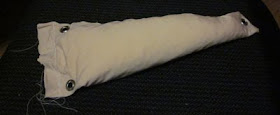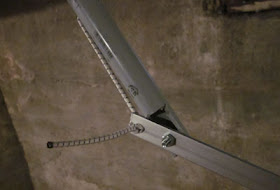Here's a short video of a walking test. It's very wobbly at the beginning, but the end is better. We'll see how it works once I get some rubber treads on it.
Tuesday, 24 August 2010
Monday, 23 August 2010
Centaur Details
This weekend I took the plunge and rebuilt the centaur skeleton. I mulled this over for quite a while, but after talking some options over with a friend, this seemed the best way to proceed.
Here's the Mark I centaur skeleton - padded aluminum harness, with everything else made of 3/4" plastic pipe. The body shape was made from layers of foam, shaved down with scissors.

If the shape looks too skinny at the back, that's because the thighs go on later.
 In this version, the legs (only half of the legs are shown here) are passively moved - like a marionette, except from below. The legs would dangle from the centaur hips, while the hoof would be fixed to a ski-like slat attached to Morgan's ankle by a sort of padded manacle.
In this version, the legs (only half of the legs are shown here) are passively moved - like a marionette, except from below. The legs would dangle from the centaur hips, while the hoof would be fixed to a ski-like slat attached to Morgan's ankle by a sort of padded manacle.The first walking tests with the ski-legs were successful, but were unsatisfying on two counts. One, they're uncomfortable. Morgan's well aware the final result might be hot, itchy and confining, but my experience with the spider legs last year taught me that skis can be trouble in an urban environment - particularly curbs.
The second problem is, well.. horses don't walk like a marching band, with left and right legs in synch. The illusion of horsiness would be much more convincing if Morgan's right leg controlled the horse's left, and vice versa. I thought I could pull this off with one arched ski and one flat ski, but I was having second thoughts.
Spring-Loaded Legs
Taking an idea from the Walking with Dinosaur 'making of' videos, I had been mulling over the idea of using bungee to create artificial tendons. The tendons would keep the legs tense, and Morgan could pull them out of position using strings. String goes around corners nicely, so I route them near the body of the horse! The lack of skis would certainly also improve the illusion.
But the first problem with this is that the good old Mark I centaur's hips just aren't that strong. The spine and hips were connected by a single stove bolt, and I was worried the joint might give on Hallowe'en night. Deep inside the costume, there would be no possibility of repair - a sad end to Trick or Treating!
Artificial Muscles
I mentioned the missing thighs before - my plan is to make them out of spandex bags, filled with polystyrene beads. Just like real flesh, these would squish out to the sides when compressed, rather than just contracting like foam.

I sew like a five year-old at the best of times, and sewing Spandex truly sucks. It bunches, it twists, and it's flexible enough for the needle to stuff it deep inside the sewing machine whenever I reverse to close off a seam. Nevertheless, I was able to get the job done, albeit messily, and dipped into a second-hand bean bag chair for the fill.
 Adding grommets to the corners, here's my finished thigh muscle prototype!
Adding grommets to the corners, here's my finished thigh muscle prototype!
A Lifetime on the Hips
In fact, if I was going to replace the plastic hips, why not replace the whole spine? Days of work came apart distressingly quickly, and soon I was on my way. Here's the new lumbar (the child end of the horse's spine, where it attaches to the harness).

It just looks durable, doesn't it?
 Old hips:
Old hips:
New hips:

Another improvement to the new hips is that the hip bolts themselves will now pass through two pieces of metal, instead of just one - this will keep the bolt much straighter, and allow a lot less wobble as the legs are worked.
Spring Loaded Legs
This part was slow. I was well aware that my sketch had a lot of missing details. There's process I've been through several times on this project, it goes like this.
- Imagine cool, ultra-realistic motion effect (e.g. the walking motion of the back leg of a horse)
- Come up with simple mechanism to achieve this effect (e.g. spring-loaded leg, with a string to lift it! Hurrah!)
- Build it
- Reality sets in. (e.g. A horse walk cycle has about eight phases to it, and that my one string can't possibly pull it off.)
Here are the legs, attached to the pelvis. I reused the plastic pipe for the upper (thigh) and lower (foot) sections, and used a piece of flat aluminum for the horizontal shin. (By the way, horse's knees don't bend backwards - the knee is much higher up and nearly obscured by the massive, disc-like thigh, and what appears to be the knee is actually the ankle. Horses literally walk on tip-toe.)
The shin extends a little beyond the plastic pipes to provide leverage for the bungee. Here's a close-up of the inside of the right knee:

This close-up also shows the main weakness of the joints, the bolts themselves. I'm using a threaded stove bolt as the hinge, but the back-and-forth action of working the joint tends to unscrew the nut. I don't want to put a washer on and make it super-tight, because that would interfere with the smoothness of the joint. The carriage (smooth) bolts I've seen are too large. My makeshift solution so far has been to crazy glue the nut in place, but this makes it hard to maintain.
I intend to revisit this later. Something I'm thinking of doing is making my own hinges by cutting lengths of aluminum rod, and then drilling holes into them to put r-clips through on each side of the leg bones.
When it was all assembled, I had a pair of rear horse legs, spring-loaded in the fully-extended-to-the-rear position. I've also added two new aluminum pieces to the hips, to build out the pelvis. Those holes near the front are to attach muscle, creating the front of the thigh between the pelvis and the knee.
 Here's Morgan, wearing the nearly completed skeleton!
Here's Morgan, wearing the nearly completed skeleton!
If you squint, you can see the strings tied to her knees. The hooves are made from a 3" PVC connector, hacksawed in half diagonally. (Tedious, but simple.)

The Walking Test
In the three walking tests to date, it's occasionally so awesome that onlookers squeal with delight, and sometimes it's so abysmal I get worried the costume will destroy itself. The problems:
- Humans swing their hips when they walk, but this causes the horse body to flail from side to side; Morgan has had to learn to walk like her hips were the front axle of a wagon.
- The aluminum straps of the harness dig into Morgan's chest.
- The harness isn't quite symmetrical (I suck at bending aluminum bars), so the horse has a slight tilt to one side.
- On smooth surfaces (e.g. our laminate floors) the hooves slide around a lot. I think I can solve this by weighting the rear hooves and adding rubber grips to the bottom. I hope that will perform nicely on concrete and grass.
Thursday, 19 August 2010
The Danger of Mediocrity
Wednesday, 18 August 2010
Centaur - Pictures Soon!
As a way of practicing for the larger dinosaur costume, I've been making a centaur costume for Morgan, my six-year old. So far I've mostly completed the skeleton, which is made of 3/4" plastic pipe, screwed together, and the core of the horse torso, which is made from a carved stack of sofa cushion foam.
Sunday I spent most of the day at the picnic table turned workbench, working on various ways to attach the costume to Morgan. I've tried to prepare her by telling her since the beginning that it might be uncomfortable, but I couldn't find a satisfactory arrangement of straps that didn't either strangle her, or affix the horse torso too loosely to her.
In the end, I've opted for thick aluminum straps which travel up her back and then bend over her shoulders in a rigid frame. This is a nice setup since there's nothing to fasten; she just wriggles in and she's good to go. (One surprise for me was that, because of kids' proportions, it took me a few tries to build something tight enough to sit properly on her shoulders, but which she could still get her head through!
Aluminum Bars!
My surprise discovery is how nice it is to work with aluminum bars. The 1/8" x 3/4" flat bars are both strong and light. Self-drilling screws go through it like butter, it's easy to saw (with a hack saw), and it's flexible enough that with the right corner, I've been able to hammer or bend it into crude curves in a pinch.
The major downside is the cost. A 4' aluminum flat rod costs over $10 at Home Depot. I'm eyeing onlinemetals.com, which is MUCH cheaper ($2 for a 4' length) and seems to ship to Canada.. for around $0.08/inch.
Sunday I spent most of the day at the picnic table turned workbench, working on various ways to attach the costume to Morgan. I've tried to prepare her by telling her since the beginning that it might be uncomfortable, but I couldn't find a satisfactory arrangement of straps that didn't either strangle her, or affix the horse torso too loosely to her.
In the end, I've opted for thick aluminum straps which travel up her back and then bend over her shoulders in a rigid frame. This is a nice setup since there's nothing to fasten; she just wriggles in and she's good to go. (One surprise for me was that, because of kids' proportions, it took me a few tries to build something tight enough to sit properly on her shoulders, but which she could still get her head through!
Aluminum Bars!
My surprise discovery is how nice it is to work with aluminum bars. The 1/8" x 3/4" flat bars are both strong and light. Self-drilling screws go through it like butter, it's easy to saw (with a hack saw), and it's flexible enough that with the right corner, I've been able to hammer or bend it into crude curves in a pinch.
The major downside is the cost. A 4' aluminum flat rod costs over $10 at Home Depot. I'm eyeing onlinemetals.com, which is MUCH cheaper ($2 for a 4' length) and seems to ship to Canada.. for around $0.08/inch.
Thursday, 5 August 2010
Tuesday, 3 August 2010
Making Of Dinosaurs
If you have $20 million dollars, here's how you'd go about making dinosaur costumes.


